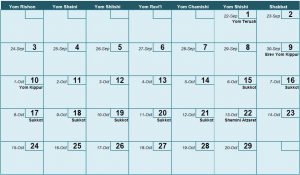About the Messianic Torah Portion Calendar
The focus of this calendar is the Biblical month, with Gregorian dates shown to facilitate ease of use.
This calendar begins each page with the first day of the Biblical month rather than the Gregorian month. For ease of use, the Gregorian dates are shown in smaller print. All of the words are in English, or if they are in Hebrew it is a transliteration (no actual Hebrew characters). Because it is English and not Hebrew, it reads from left to right. If this were a real Hebrew calendar with Hebrew markings, it would read right-to-left, with the first day of the week on the right side and the Sabbath on the left.
While there is some debate on the details of the Biblical Calendar, the principles are well defined in Scripture. We know the day is determined by the setting and rising of the sun, though we may debate on exactly when that is. We know that the month is determined by the new moon, though we may debate on exactly when that is. We know that the year is determined by the seasons, though we may debate on exactly how that is known.
The Calendar Design
This is a 13-month calendar that begins with the seventh month, known as Tishrei or Ethanim, of the Hebrew year 5785. The traditional numbering of years advances at the beginning of the seventh month. During the seventh month we celebrate the “Feast of Ingathering,” Sukkot, which Exodus 43:22 describes as “the turn of the year.” This is the time when the traditional Torah reading cycle begins and ends. This calendar goes through the seventh month, the beginning of the new Hebrew year 5786.
The purpose of this calendar is to move the focus from the Gregorian to the Biblical months. Each month is based on the traditional Hebrew calendar that, according to Rabbinic tradition, was created by Hillel II. It has been used for many years by Jews inside and outside the land of Israel for unified observance of Holy Days. Names for the Appointed Times are taken from Leviticus 23, with the exception of the Eighth Day Assembly, Shemini Atzeret, which is taken from Numbers 29:35. Other Biblical observances (the four fasts (Zechariah 8:19), Purim (Esther 9:19) and Hanukkah (1 Maccabees 4:59) are also listed.
The Torah reading schedule corresponds to the Hebrew months, and begins immediately following Sukkot (the Feast of Tabernacles) “at the turn of the year” (Exodus 34:22).
You can view the Messianic Torah Portion Calendar Here
This calendar ©2024 MessianicLight.com and is not to be sold or reproduced in print or digital media without permission. To do so is theft, a violation of Torah and the eighth commandment.
You can download a full calendar detailing the Torah, Haftarah and Brit Chadashah (New Testament) readings at MessianicLight.com.

